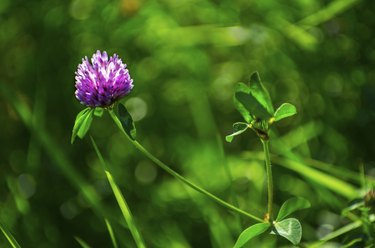
Both red and white clover are perennial legumes high in protein and fiber that are widely used as forage for animal grazing and pastures. They are typically planted with companion grasses and used as a cover crop during crop rotation, particularly organic crops. Besides the obvious fact that one grows red or purple flowers while the other grows white flowers, several other differences exist between red and white clover as well, including how they are classified, how they grow and what they are used for. This includes purported health benefits for humans attributed to one but not the other.
Varieties
Video of the Day
Red and white clover are each divided into three basic classifications. Red clover is classified by its growing season, with early flowering, intermediate flowering and late flowering varieties. White clover is classified by its size, with small, medium and large varieties. The most commonly seen variety of white clover in the wild is Dutch clover, also known as common white clover, and it is a small to medium sized variety. Ladino clover, the variety most often planted for grazing, is double its size.
Video of the Day
Planting and Growth
Red clover grows tall and upright, while white clover grows shorter in height and spreads laterally. Red clover is has a short life-cycle, approximately two to three years, while white clover is a persistent grower that can reseed itself, even under grazing conditions. When planting clover, it's best to plant a mixture of red and white clover together.
Use
White clover is considered best for grazing, while red clover is considered best for pasture and wildlife habitat, as it can quickly be depleted if grazed continuously. Both are considered helpful in improving and nitrogen-fixing the soil.
Human Health Benefits
Herbalists revere red clover for several purported health benefits, including detoxification, decongestion and reducing inflammation. Red clover is also considered a rich source of isoflavones, an antioxidant associated in some studies with combating certain types of cancer, including breast cancer and prostate cancer. The isoflavones in red clover have also been found beneficial in reducing bone loss and menopausal symptoms in healthy women. White clover has not been found to possess the same constituents or health benefits. Remember that no herbs have been FDA-approved for medical use and you should always consult with your doctor before taking red clover tea for any health-related purpose. All clovers, including white, possess some amount of vitamins A, E, C, B-2, and B-3, calcium, chromium, lecithin, magnesium, potassium and silicium.
- "Frontiers In Bioscience"; The Role Of Isoflavones In Cancer Chemoprevention"; F.H. Sarkar, et al.; Sep 2004
- "Breast Cancer Research"; Isoflavones And Women's Health; Trevor Powles; 2004
- University Of Kentucky Cooperative Extension; "Red And White Clover"; Garry Lacefield; Dec 2009
- University Of Maryland Medical Center; Red Clover; Steven D. Ehrlich; Dec 2008